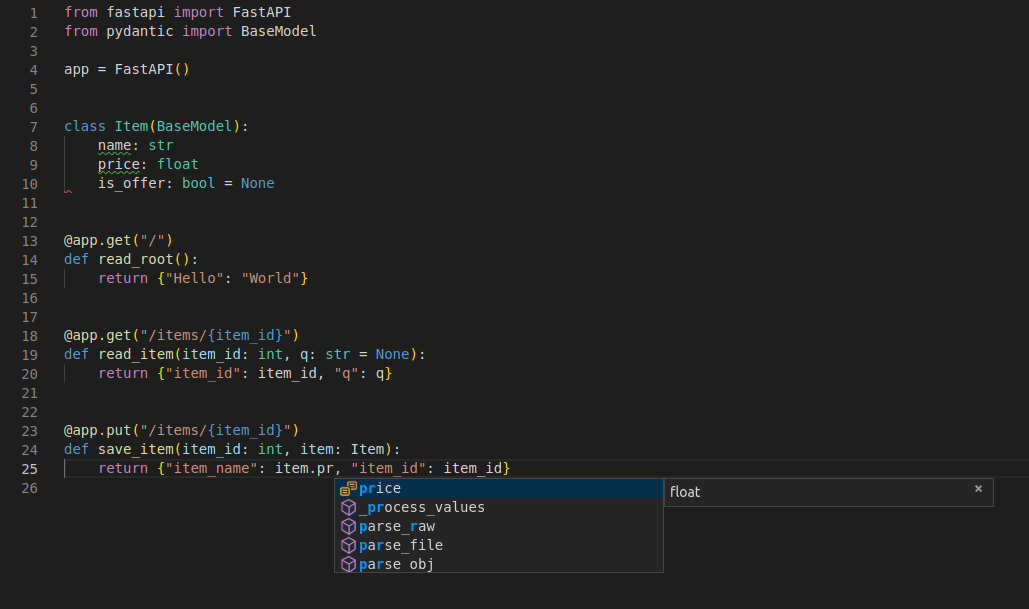- Sort Score
- Result 10 results
- Languages All
Results 51 - 60 of 105 for Night (0.13 sec)
-
docs/en/docs/advanced/websockets.md
And to communicate using WebSockets with your backend you would probably use your frontend's utilities. Or you might have a native mobile application that communicates with your WebSocket backend directly, in native code. Or you might have any other way to communicate with the WebSocket endpoint. ---
Plain Text - Registered: Sun May 05 07:19:11 GMT 2024 - Last Modified: Thu May 02 22:37:31 GMT 2024 - 6.2K bytes - Viewed (0) -
docs/en/docs/advanced/openapi-webhooks.md
This can make it a lot easier for your users to **implement their APIs** to receive your **webhook** requests, they might even be able to autogenerate some of their own API code. !!! info Webhooks are available in OpenAPI 3.1.0 and above, supported by FastAPI `0.99.0` and above. ## An app with webhooksPlain Text - Registered: Sun May 05 07:19:11 GMT 2024 - Last Modified: Thu May 02 22:37:31 GMT 2024 - 2.8K bytes - Viewed (0) -
docs/en/mkdocs.yml
palette: - media: '(prefers-color-scheme: light)' scheme: default primary: teal accent: amber toggle: icon: material/lightbulb name: Switch to dark mode - media: '(prefers-color-scheme: dark)' scheme: slate primary: teal accent: amber toggle: icon: material/lightbulb-outline name: Switch to light mode features: - search.suggestOthers - Registered: Sun May 05 07:19:11 GMT 2024 - Last Modified: Thu May 02 22:37:31 GMT 2024 - 9.1K bytes - Viewed (0) -
docs/en/docs/async.md
--- If you just don't know, use normal `def`. --- **Note**: You can mix `def` and `async def` in your *path operation functions* as much as you need and define each one using the best option for you. FastAPI will do the right thing with them. Anyway, in any of the cases above, FastAPI will still work asynchronously and be extremely fast. But by following the steps above, it will be able to do some performance optimizations.
Plain Text - Registered: Sun May 05 07:19:11 GMT 2024 - Last Modified: Thu Apr 18 19:53:19 GMT 2024 - 23K bytes - Viewed (0) -
docs/en/docs/features.md
The whole **FastAPI** framework is based to satisfy that. Autocompletion works everywhere. You will rarely need to come back to the docs. Here's how your editor might help you: * in <a href="https://code.visualstudio.com/" class="external-link" target="_blank">Visual Studio Code</a>: 
Plain Text - Registered: Sun May 05 07:19:11 GMT 2024 - Last Modified: Thu May 02 22:37:31 GMT 2024 - 9.3K bytes - Viewed (0) -
docs/en/docs/tutorial/dependencies/dependencies-in-path-operation-decorators.md
Some editors check for unused function parameters, and show them as errors. Using these `dependencies` in the *path operation decorator* you can make sure they are executed while avoiding editor/tooling errors. It might also help avoid confusion for new developers that see an unused parameter in your code and could think it's unnecessary. !!! info In this example we use invented custom headers `X-Key` and `X-Token`.Plain Text - Registered: Sun May 05 07:19:11 GMT 2024 - Last Modified: Tue Oct 17 05:59:11 GMT 2023 - 4.1K bytes - Viewed (0) -
docs/en/docs/tutorial/dependencies/sub-dependencies.md
Just functions that look the same as the *path operation functions*. But still, it is very powerful, and allows you to declare arbitrarily deeply nested dependency "graphs" (trees). !!! tip All this might not seem as useful with these simple examples. But you will see how useful it is in the chapters about **security**.
Plain Text - Registered: Sun May 05 07:19:11 GMT 2024 - Last Modified: Tue Oct 17 05:59:11 GMT 2023 - 5.6K bytes - Viewed (0) -
docs/en/docs/tutorial/path-operation-configuration.md
They will be added to the OpenAPI schema and used by the automatic documentation interfaces: <img src="/img/tutorial/path-operation-configuration/image01.png"> ### Tags with Enums If you have a big application, you might end up accumulating **several tags**, and you would want to make sure you always use the **same tag** for related *path operations*. In these cases, it could make sense to store the tags in an `Enum`.
Plain Text - Registered: Sun May 05 07:19:11 GMT 2024 - Last Modified: Tue Oct 17 05:59:11 GMT 2023 - 5.5K bytes - Viewed (0) -
docs/en/docs/advanced/openapi-callbacks.md
!!! tip When writing the code to document a callback, it might be useful to imagine that you are that *external developer*. And that you are currently implementing the *external API*, not *your API*.Plain Text - Registered: Sun May 05 07:19:11 GMT 2024 - Last Modified: Thu May 02 22:37:31 GMT 2024 - 7.7K bytes - Viewed (0) -
docs/en/docs/tutorial/extra-models.md
```Python UserInDB( username="john", password="secret", email="******@****.***", full_name=None, ) ``` Or more exactly, using `user_dict` directly, with whatever contents it might have in the future: ```Python UserInDB( username = user_dict["username"], password = user_dict["password"], email = user_dict["email"], full_name = user_dict["full_name"], ) ```Plain Text - Registered: Sun May 05 07:19:11 GMT 2024 - Last Modified: Thu Apr 18 19:53:19 GMT 2024 - 7.7K bytes - Viewed (1)